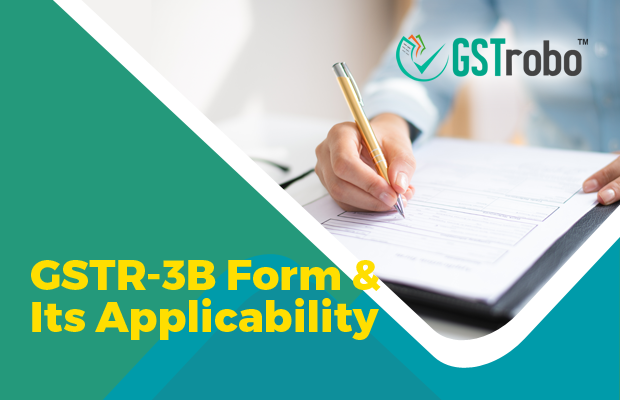GSTR-3B Form and Its Applicability
Since the introduction of GST in India, several GST return forms have been implemented and GSTR-3B is one such GST return form. In this blog, we will discuss what the GSTR-3B form is and its applicability.

What is GSTR-3B?
GSTR-3B is a monthly self-declaration form that needs to be furnished by all the registered taxable persons along with the GSTR-1 form. GSTR-3B form consists of a summary of output liabilities and ITC for a tax period.
Note: Under Quarterly Return Monthly Payment (QRMP) Scheme the notified taxpayer with aggregate turnover of up to INR 5 Crores can file GSTR-3B quarterly but needs to make the monthly payment.
Who should file GSTR-3B?
All registered taxable person needs to file GSTR-3B except the following:
- Input Service Distributors (ISD)
- Composition Scheme Holders
- Suppliers of Online Information Database Access and Retrieval Services (OIDAR)
- Non-Resident Taxable Person (NRTP)
- TDS Deductor
- TCS Collector
Due date to file GSTR-3B?
This GSTR-3B is a monthly return that has to be filed by the notified taxpayers. However, the date of filing varies based on the aggregate turnover and state of the taxpayers. Let us understand this with the following table:
| Aggregate Turnover | Area | Due Date |
| Less than INR 5 Crores | Every State | 20th of the following month |
| INR 5 Crores | Every State | 20th of the following month |
| More than INR 5 Crores | Chhattisgarh Madhya Pradesh Gujarat Maharashtra Karnataka Goa Kerala Tamil Nadu Telangana Andhra Pradesh Daman & Diu Dadra & Nagar Haveli Puducherry Andaman and Nicobar Islands Lakshadweep | 22nd of the following month |
| More than INR 5 Crores | Himachal Pradesh Punjab Uttarakhand Haryana Rajasthan Uttar Pradesh Bihar Sikkim Arunachal Pradesh Nagaland Manipur Mizoram Tripura Meghalaya Assam West Bengal Jharkhand Odisha Jammu and Kashmir Ladakh Chandigarh Delhi | 24th of the following month |
Late Fee & Penalty
In case if you file GSTR-3B after the due-date you need to pay the late fees along with interest as mentioned below:
- INR 50 per day
- INR 20 per day for taxpayers who have a nil tax liability
18% per annum interest is payable on the outstanding amount of tax that has to be paid.
Moreover, it shall be noted that both late fees and interest will be applicable even if the tax is paid within the due date but the GSTR-3B was filed after the due date.
Why the reconciliation of GSTR-3B, GSTR-2A and GSTR-2B is important?
Reconciliation of GSTR-3B, GSTR-2A and GSTR-2B is important to:
- Avoid excess ITC claims in GSTR-3B
- Stay up-to-date whether the supplier has uploaded and filed the invoice details on GSTR-1.
- Never miss out on any genuine Input tax credit.
- Avoid notices from the GST authorities and stay GST compliant.
- Enhance GST Compliance rating
Why the reconciliation of GSTR-3B and GSTR-1 is important?
Reconciliation of GSTR-3B and GSTR-1 is important to:
- Avoid consequences that may occur due to the short payment of tax.
- Stay up-to-date if any invoice is duplicated or missed out.
- Accurate liability calculation
- Accurate tax payment etc.
- Auto-calculation of table 3.1 and 3.2
Points to Note
- In case if you have filed a nil GST return you still need to file GSTR-3B.
- Once furnished GSTR-3B cannot be revised or amended.
- For each GSTIN the taxpayer needs to file a separate GSTR-3B.
- Taxpayers filing quarterly GSTR-1 returns must still pay tax and file GSTR-3B every month.
Author
Devesh Gupta
Content Specialist, GSTrobo®
